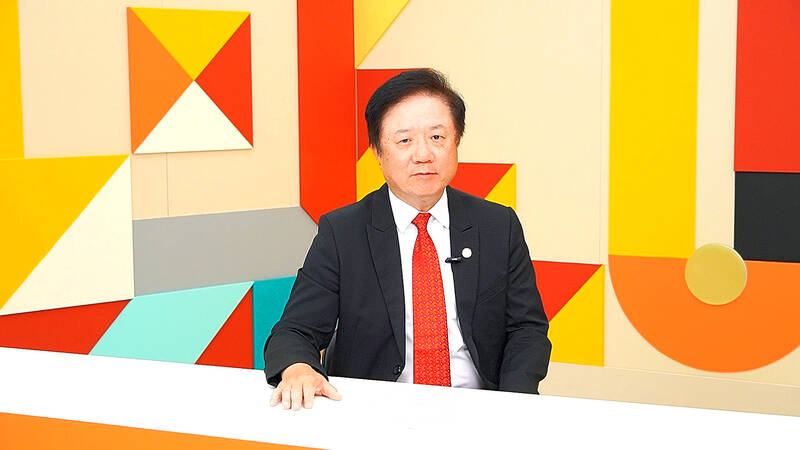Taiwan plans to launch its first sovereign satellite by the end of the year, Chunghwa Telecom Co (CHT, 中華電信) President Chien Chih-cheng (簡志誠) said yesterday.
The telecom announced that it was prepared to sign an agreement with US-based Astranis Co to launch a dedicated satellite over which Chunghwa Telecom would have independent control, marking the foundation of a national satellite project.
The race to put more satellites in space is becoming “white hot,” and it is imperative that Taiwan joins the race as soon as possible and creates terrestrial applications for satellites, as well as has comprehensive coverage across all orbits, Chien said in an exclusive interview with the Liberty Times (sister paper of the Taipei Times).

Photo: Chang Chia-jui, Taipei Times
Chien stressed the importance of building greater communications resilience by expanding satellite bandwidth, adding that state assistance would be essential to achieving it.
The Astranis collaboration would add to Taiwan’s high Earth orbit satellites, such as the ST-2 satellites and the 2023 project to ensure continued access to high Earth orbit satellite coverage, he added.
More than half of the nation’s 5G networks are using the Ka band of satellite communications, which is also being used by most of the newly launched satellites globally, Chien said.
Chunghwa Telecom has expanded into undersea cables, fixed-line and broadband networks, and microwave communications, and collaborated with other companies to launch low and medium Earth orbit satellites as well as geostationary satellites over the past few years to bolster the nation’s network resilience, he said.
The collaboration with Astranis, which would give the telecom access to the compact geostationary orbit satellite’s 8 gigabits per second bandwidth as early as next year, would be the Taiwan’s first exclusive communications satellite, Chien said.
It would realize the nation’s goal of having autonomous and secure telecommunications capabilities in case of an earthquake or geopolitical events, he added.
Taiwan has also been given exclusive access to SES’ medium Earth orbit system, the O3b mPOWER, he said.
The deal was inked last year and is being processed, after it failed applications with the Ministry of Digital Affairs and the National Communications Commission, Chien said.
The nation signed deals for exclusive access to satellite bandwidth from OneWeb, Kuiper and Telesat as well, he said, adding that access to OneWeb’s bandwidth was approved on June 3.
The company has given great thought to how Taiwan would play a part in network services, which has been the mindset behind Chunghwa Telecom’s inclusion of a clause during negotiations that satellite ground stations should use Taiwan-manufactured equipment, Chien said.
For example, Chunghwa Telecom in its negotiations with OneWeb demanded the inclusion of Taiwanese companies in network access tests before access is provided worldwide, he said, adding that such strategies helped bring Taiwan into the fold of the satellite industry and ensure that the industry is on a par with international standards.
Separately, to improve the resiliency of the nation’s international communication networks, Chunghwa aims to install seven new submarine cables and a landing station, Chien said.
The telecom currently operates seven cables and four landing stations, he added.
Two of the new cables are set to go online in the second half of this year, one connecting Taiwan to Japan, Singapore and Hong Kong, and the other connecting Taiwan, Japan, Singapore and India, he said.
A new trans-Pacific fiber optic submarine cable, dubbed E2A, is set to go online in 2028, he added.
Taiwan also has nine domestic cables connecting Taiwan proper with the nation’s outlying islands, Chien said, adding that a fourth cable between Taiwan, and Penghu, Kinmen and Lienchiang (Matsu) counties is under construction and expected to be completed next year.
The company is investing in new technologies in building the submarine cables, including artificial intelligence, to ensure resiliency, he said.
The goal is to turn Taiwan into a regional hub for the communications industry, driving growth, job creation and the development of technology, Chien said.
Responding to concerns about ships damaging submarine cables, Chien said the company has taken measures such as adding protective layers, burying cables deeper underground and improving cooperation with the Coast Guard Administration.

TRAGEDY STRIKES TAIPEI: The suspect died after falling off a building after he threw smoke grenades into Taipei Main Station and went on a killing spree in Zhongshan A 27-year-old suspect allegedly threw smoke grenades in Taipei Main Station and then proceeded to Zhongshan MRT Station in a random killing spree that resulted in the death of the suspect and two other civilians, and seven injured, including one in critical condition, as of press time last night. The suspect, identified as a man surnamed Chang Wen (張文), allegedly began the attack at Taipei Main Station, the Taipei Fire Department said, adding that it received a report at 5:24pm that smoke grenades had been thrown in the station. One man in his 50s was rushed to hospital after a cardiac arrest

SAFETY FIRST: Double the number of police were deployed at the Taipei Marathon, while other cities released plans to bolster public event safety Authorities across Taiwan have stepped up security measures ahead of Christmas and New Year events, following a knife and smoke bomb attack in Taipei on Friday that left four people dead and 11 injured. In a bid to prevent potential copycat incidents, police deployments have been expanded for large gatherings, transport hubs, and other crowded public spaces, according to official statements from police and city authorities. Taipei Mayor Chiang Wan-an (蔣萬安) said the city has “comprehensively raised security readiness” in crowded areas, increased police deployments with armed officers, and intensified patrols during weekends and nighttime hours. For large-scale events, security checkpoints and explosives

A car bomb killed a senior Russian general in southern Moscow yesterday morning, the latest high-profile army figure to be blown up in a blast that came just hours after Russian and Ukrainian delegates held separate talks in Miami on a plan to end the war. Kyiv has not commented on the incident, but Russian investigators said they were probing whether the blast was “linked” to “Ukrainian special forces.” The attack was similar to other assassinations of generals and pro-war figures that have either been claimed, or are widely believed to have been orchestrated, by Ukraine. Russian Lieutenant General Fanil Sarvarov, 56, head

PUBLIC SAFETY: The premier said that security would be tightened in transport hubs, while President Lai commended the public for their bravery The government is to deploy more police, including rapid response units, in crowded public areas to ensure a swift response to any threats, President William Lai (賴清德) said yesterday after a knife attack killed three people and injured 11 in Taipei the previous day. Lai made the remarks following a briefing by the National Police Agency on the progress of the investigation, saying that the attack underscored the importance of cooperation in public security between the central and local governments. The attack unfolded in the early evening on Friday around Taipei Main Station’s M7 exit and later near the Taipei MRT’s Zhongshan